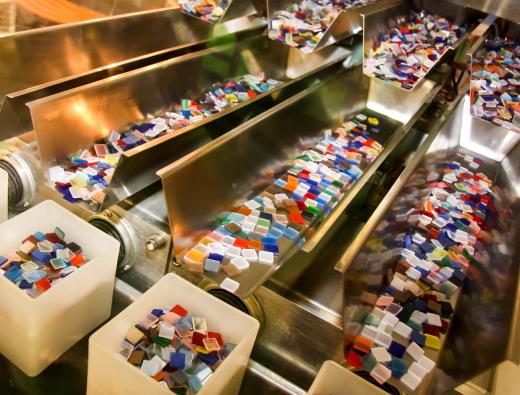At AboutMechanics, we're committed to delivering accurate, trustworthy information. Our expert-authored content is rigorously fact-checked and sourced from credible authorities. Discover how we uphold the highest standards in providing you with reliable knowledge.
What Are the Different Types of Industrial Conveyor Belts?
Industrial conveyor belts are systems designed to move materials or objects over a set distance using a belt wrapped around a series of rotating cylinders, though other designs exist as well. An auger conveyor, for example, uses a large screw mechanism to move materials rather than a belt. The specific design, size, shape, and construction materials of industrial conveyor belts can vary significantly based on the intended purpose of the unit. Some conveyor systems are even mobile to allow repositioning of the system or transport to a specific job site.
The most basic types of industrial conveyor belts feature parallel frames with a series of metal cylinders mounted in between, perpendicularly to the frames. These cylinders are mounted on axles that are in turn mounted to the frames, allowing for free rotation of the cylinders when an object is placed on them and pushed forward. Such industrial conveyor belts do not actually feature belts at all, but instead facilitate movement over the bare cylinders; they are usually unpowered, and they are useful in smaller settings in which sorting or inspection is done.

Belt-type conveyor systems feature a belt wrapped around the cylinders. The belt will provide a flatter surface for items to be moved, and it can prevent materials from sliding in between the cylinders, thereby causing a jam or damaging the cylinders themselves. These systems are usually motorized to facilitate easier movement of bulky or heavy items or materials. The track does not necessarily need to be straight; curves and corners can be built into the system to accommodate the needs of a particular industrial setting.

Sometimes it is necessary to replace the rubber belt with a belt made from another material. This is common on industrial conveyor belts used in the food industry, since rubber can contaminate food. Rubber belts are also more difficult to clean, especially in food processing settings. Metal mesh belts are often used instead because they are less likely to contaminate the food, they are much easier to clean, and they allow for better ventilation. Solid metal sheets can be used as well, though this is less likely and a far more expensive option than metal mesh.

Very often, industrial conveyor belts feature wheels or tracks that allow the entire system to be repositioned or transported to a new location. Belt systems used in quarries, for example, can be quite large, and they may feature wheels so a towing vehicle can reposition the system as necessary; the height of the belt is usually adjustable as well, so one end of the conveyor can be positioned higher than the other.
AS FEATURED ON:
AS FEATURED ON:














Discuss this Article
Post your comments